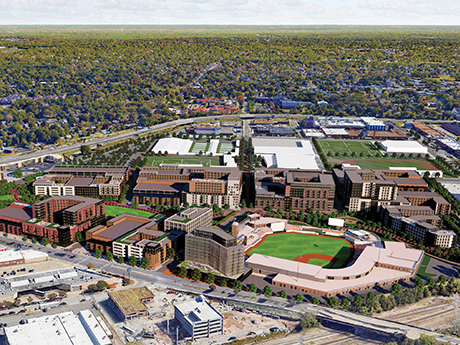Centrally located between the rolling hills of the Blue Ridge Mountains and the sandy beaches of the Atlantic Ocean, Richmond, the capital of the state of Virginia, remains a vibrant city with an educated and growing workforce that benefits from the city’s thriving and diverse economy.
According to data from the U.S. Bureau of Labor Statistics, in Richmond, home to eight Fortune 500 companies and three Fortune 1000 companies, the unemployment rate of 2.8 percent is a 10 basis point decrease from a year ago. It is slightly higher than the state’s unemployment rate of 2.7 percent but far below the national rate of 4.3 percent.

Richmond’s labor market remains robust, adding over 38,000 new jobs from the first quarter of 2020 through summer 2024. In the last 36 months alone, CoStar Group (2,000 new jobs), LEGO (1,760 new jobs), and SanMar (1,000 new jobs) have announced significant corporate and capital commitments to the market. Government and education/healthcare remain the largest regional employment sectors, posting the highest year-over-year employment gains of 3.7 percent and 4.7 percent, respectively.
Richmond’s continued ability to retain and attract talent due to a high quality of life, affordable cost of living and access to a wealth of local and regional amenities has had a profound impact on the region’s multifamily performance in recent years. Strong housing fundamentals, particularly in the post-pandemic years, clearly position Richmond as one of the top performing markets in the Mid-Atlantic and Southeast.
Many of Richmond’s comparable markets are experiencing negative year-over-year rent growth due to weaker demand and ample supply. The city’s 3.4 percent rent growth over the past 12 months, while below the five-year average of 5.4 percent, clearly sets the MSA apart from other large regional markets. Leading research firms expect rent growth trends to return to historical average levels starting in 2025, but also below the peaks of the pandemic years.
Richmond’s average monthly rent of $1,537 is relatively affordable compared to other markets and well below many metro areas across the country. Rent growth remains strong in all submarkets, especially in areas like Petersburg/Hopewell where there is no new development. With supply set to decline over the next 24 to 36 months due to rising interest rates, construction costs and tighter lender standards, increased demand in Richmond will likely lead to stronger growth and higher rent prices.
Richmond’s strong absorption and occupancy rates also cast a positive light on the market. A recent increase in new construction development since 2020, evenly distributed across the region, with strong activity in the Manchester, Central Business District, Scott’s Addition, Northwest and Southwest Chesterfield submarkets, indicates solid tenant demand across all areas of the market.
Richmond has seen more than 2,000 units delivered in each of the last five years. While this is considered unprecedented and on the verge of oversupply, it represents less than 2 percent of the total multifamily housing inventory on the market.
The emerging neighborhoods in the CBD have seen the most dramatic growth. Developers and tenants alike are attracted by the walkability and proximity to the area’s most trend-setting developments. The Diamond District, for example, is a $2.4 billion development spanning nearly 70 acres in the city and including a new minor league baseball stadium, 1,700 residential units, hotels and Class A office space.
Surrounding communities also see great growth opportunities. GreenCity, the $2.3 billion eco-district in nearby Henrico County, will include 2 million square feet of office space, 2,400 residential units, two hotels and a 17,000-seat sports arena. With just under 6,000 units currently under construction in the market, the supply pipeline has been drastically reduced from its 2023 peak, suggesting a slight slowdown. Demand for Class A product is strong, with over 2,200 units absorbed in the first half of 2024, outpacing new deliveries.
Overall demand for multifamily housing across all product classes in the Richmond market is solid and consistent with historical averages. Through the second quarter of 2024, Richmond’s occupancy rate is 94.3 percent and is expected to remain above 95 percent for the next four years. All eight submarkets report strong occupancy rates, with only the East Richmond submarket (92.6 percent) reporting below 93 percent. According to Globe Street, Richmond was one of only eight major markets in the United States to report year-over-year occupancy rate growth in the second quarter of 2024.
While Richmond’s home prices continue to outperform other regional markets, multifamily sales have remained sluggish in 2024. After peak sales years during the pandemic, transaction volumes in the second quarter were well below historical averages. Rising interest rates, tighter lender requirements and a turbulent geopolitical environment have negatively impacted property values and resulted in fewer investment sales in the market.
The current headwinds on the sales side will likely turn into a more active position in the fourth quarter of this year and beyond. Richmond is enjoying unprecedented positive momentum in population growth, local and regional business practices, and overall multifamily fundamentals – all indicators that the city is well positioned as a leading housing market and attractive destination for investors going forward.
— By Charles Wentworth, Executive Managing Director of Investment Sales – Multifamily Capital Markets at Newmark. This article was originally published in the August 2024 issue of Real estate business in the southeast.

